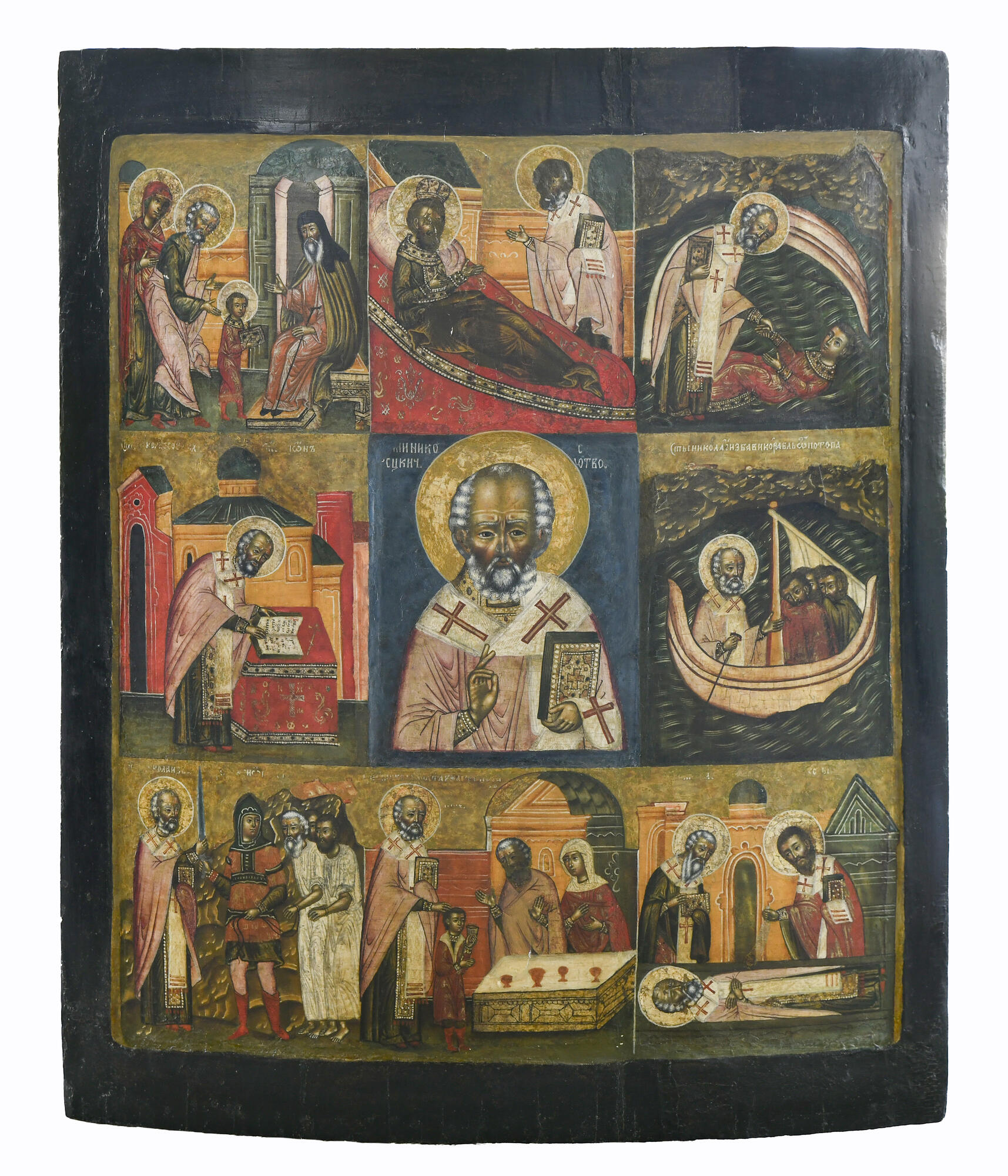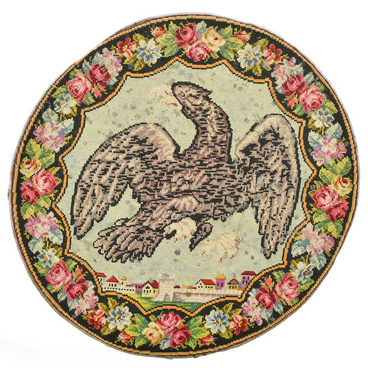The hagiographic icon ‘Saint Nicholas the Wonderworker (Velikoretsky)’ is on display at the Bishop’s House. In the center, the saint is portrayed as a gray-haired elder against a dark blue background. His right hand is raised in the gesture of blessing; his left hand holds the closed Gospel. Saint Nicholas wears a phelonion — a traditional sleeveless liturgical vestment worn by a priest. On top of it, he wears an omophorion — a broad white scarf with red crosses, a detail of the bishop’s vestment. A wide halo with gilded details surrounds the saint’s head.
Around the centerpiece, there are eight border scenes — miniature compositions, each depicting a separate event from the life of the saint. They scenes go from left to right and from top to bottom: the upper row, the two scenes flanking the centerpiece, and finally the lower row. Next to each image, there are explanatory inscriptions: “Bringing to teaching”, “Appearance of Nicholas to Tsar Constantine in a dream”, “Rescue of Demetrius from the bottom of the sea”, “Service of Saint Nicholas in Zion”, “Return of Basil son of Agrikov to parents”, “Miracle of the shipmen”, “Deliverance from Saracen captivity”, “Presentation of Nicholas”.
The iconographer drew a monochrome dark blue frame along the outline of the board. The border scenes are separated from each other by a colored background. The main tones in this image are red-brown and olive green.
In Siberia, icons of Nicholas the Wonderworker were kept in almost every house — from a poor peasant hut to the governor’s mansion. This saint was revered as the patron saint of small children, farmers, beekeepers, sailors, and travelers. His Memorial Day was celebrated twice a year — in summer and in winter. The holidays, respectively, were called the ‘Summer Feast of St Nicholas’ and ‘Winter Feast of St Nicholas’.
Sometimes Nicholas the Wonderworker was called the most senior saint. Some peasants even believed that the Holy Trinity consisted not of the Father, the Son, and the Holy Spirit, but of Christ, the Virgin Mary, and Nicholas the Wonderworker. In the number of icons of various kinds and temples consecrated in his honor, this saint was second only to the Virgin Mary. And his name was the most popular in Russia until the beginning of the twentieth century.
Around the centerpiece, there are eight border scenes — miniature compositions, each depicting a separate event from the life of the saint. They scenes go from left to right and from top to bottom: the upper row, the two scenes flanking the centerpiece, and finally the lower row. Next to each image, there are explanatory inscriptions: “Bringing to teaching”, “Appearance of Nicholas to Tsar Constantine in a dream”, “Rescue of Demetrius from the bottom of the sea”, “Service of Saint Nicholas in Zion”, “Return of Basil son of Agrikov to parents”, “Miracle of the shipmen”, “Deliverance from Saracen captivity”, “Presentation of Nicholas”.
The iconographer drew a monochrome dark blue frame along the outline of the board. The border scenes are separated from each other by a colored background. The main tones in this image are red-brown and olive green.
In Siberia, icons of Nicholas the Wonderworker were kept in almost every house — from a poor peasant hut to the governor’s mansion. This saint was revered as the patron saint of small children, farmers, beekeepers, sailors, and travelers. His Memorial Day was celebrated twice a year — in summer and in winter. The holidays, respectively, were called the ‘Summer Feast of St Nicholas’ and ‘Winter Feast of St Nicholas’.
Sometimes Nicholas the Wonderworker was called the most senior saint. Some peasants even believed that the Holy Trinity consisted not of the Father, the Son, and the Holy Spirit, but of Christ, the Virgin Mary, and Nicholas the Wonderworker. In the number of icons of various kinds and temples consecrated in his honor, this saint was second only to the Virgin Mary. And his name was the most popular in Russia until the beginning of the twentieth century.



